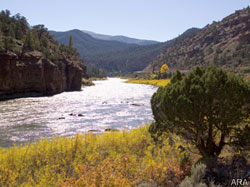
(ARA) – Do you ever think about how the water coming out of your faucet makes its way into your home? Or look out at the river as you’re driving to work and expect it will always look the same? Though water is often perceived as an infinite resource that can’t become endangered, by 2015, a majority of U.S. states may face water shortages. Some of those places may be right there in your backyard, and the loss of these ecosystems could affect your daily life.
Luckily, there are organizations that work to protect the water and the land around the world. The Nature Conservancy – a worldwide leader in freshwater protection – currently has hundreds of river and lake projects underway throughout the United States, positively impacting many of the areas where we live.
Freshwater conservation is important because, in addition to being the water we drink, it’s used to water our crops, gives us fish to eat, powers our factories, lights our homes, transports goods and carries people back home. Freshwater conservation is an investment in our future.
The Nature Conservancy toils diligently to keep rivers and lakes that provide drinking water clean and healthy, but needs funds and volunteers for its efforts. That’s why Crystal Light is collaborating with the Conservancy to support five local river and lake projects to help protect key sources of clean, fresh drinking water. For more information on the collaboration, visit the Crystal Light Facebook fan page at www.Facebook.com/CrystalLight. The site will be updated frequently to track the progress of the five projects Crystal Light is supporting around the United States:
Colorado River
The river is the lifeblood of the intermountain West and touches seven states. It has been impacted by rapid population growth in the west.
Great Lakes Basin
The Great Lakes Basin holds a fifth of the fresh surface water on Earth and impacts millions of Americans living along its shores. Even here, freshwater resources are in trouble as a result of climate change, water development and use.
Meramec River (Mississippi)
The Meramec River, part of the Mississippi River, supplies drinking water to more than 15 million people and serves as a habitat for thousands of fish, birds and other wildlife. Over time, it has been threatened by excessive use, and is one of the Conservancy’s highest priorities.
Potomac River
The Potomac River provides drinking water to 4.3 million people living in Maryland, Virginia, West Virginia and the District of Columbia. It is being impacted by rapid population growth and land use change in the basin.
Southern Rivers
Southern rivers and streams, such as the Pascagoula River in Mississippi and the Flint River in Georgia, span all 15 southern states. Recent droughts and increasing water demands have threatened these important bodies of water.
To learn more about the work The Nature Conservancy is doing across the country, visit its Web site, www.nature.org. To learn about how Crystal Light is supporting this important issue, visit www.Facebook.com/CrystalLight.
Courtesy of ARAcontent
###
SIDEBAR:
Making changes that protect our water supply
By taking small steps in the right direction and making environmentally friendly choices, each of us has the power to positively impact freshwater conservation. Here are just a few ways you can start to make a big difference:
1. Reuse water you washed your fruits and vegetables with to water plants around your house.
2. Install a low-flow showerhead to limit the amount of water used in your daily shower.
3. Turn off the faucet as you soap your hands, wash your face and brush your teeth.
4. Make sure to check your plumbing frequently to ensure there are no leaks that waste water.
Courtesy of ARAcontent





